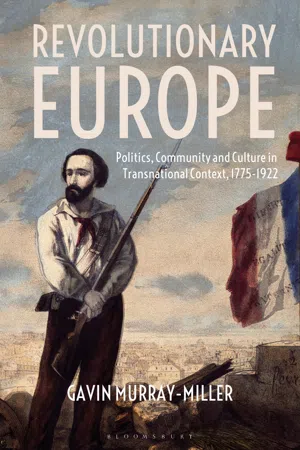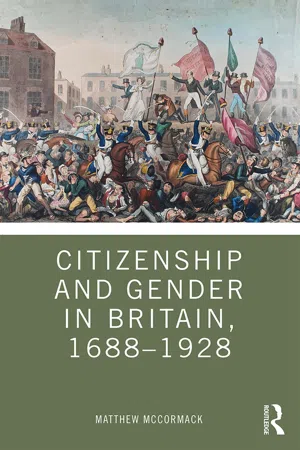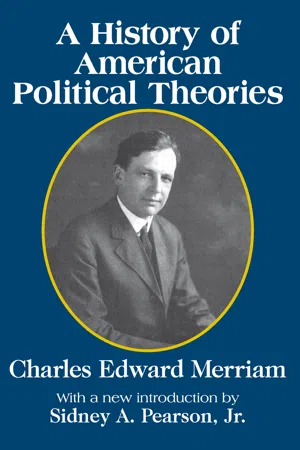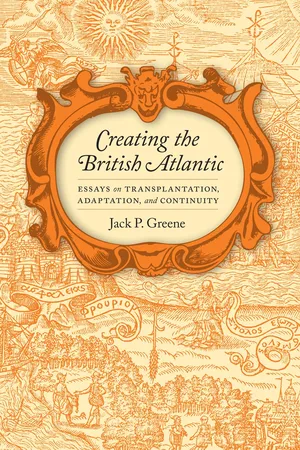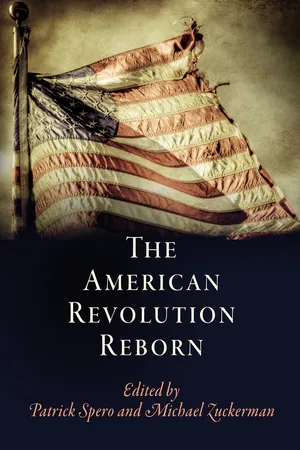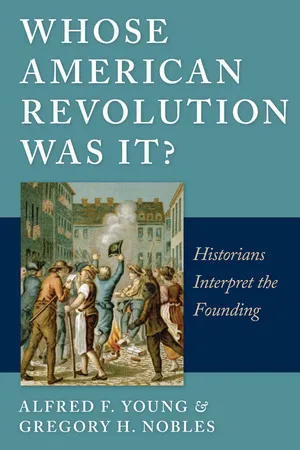History
Patriots American Revolution
The Patriots in the American Revolution were the colonists who rebelled against British rule and sought independence from Great Britain. They were motivated by a desire for self-governance, individual rights, and economic freedom. The Patriots played a crucial role in the Revolutionary War and ultimately secured the establishment of the United States of America as an independent nation.
Written by Perlego with AI-assistance
Related key terms
7 Key excerpts on "Patriots American Revolution"
- eBook - ePub
Revolutionary Europe
Politics, Community and Culture in Transnational Context, 1775-1922
- Gavin Murray-Miller(Author)
- 2020(Publication Date)
- Bloomsbury Academic(Publisher)
Revolutionaries had little inclination to alter existing governmental structures or social conditions. On the contrary, British modifications to imperial structures had been a prime cause of colonial discontent, and Americans would uphold the racial subjugation that empire supported after independence. 41 Patriotism and race came to shape specific conceptions of “the people” that hinted at the exclusionary nature of the modern citizenship regime, with loyalists, slaves and Native Americans among the “casualties” of republican nation-building. 42 If the patriot revolution bore the marks of its reactionary character, independence did invest the “revolutionary” nature of patriot protest with new meaning. In 1779, the congressman Gouverneur Morris drafted a rebuttal to the British Commission on Conciliation entitled Observations on the American Revolution, one of the first official uses of the term. By the early 1780s, statesmen such as George Washington were inclined to make references to “our revolution” in public speeches and writing. 43 In 1782, Thomas Paine, always a zealous defender of the patriot cause, corroborated America’s revolutionary credentials in a public exchange with the French political writer and cleric Guillaume Thomas Raynal. While the abbé expressed doubt as to whether a settler revolt over taxes constituted a significant “revolution,” Paine took the liberty of correcting his “uniformed” opinion, claiming that America had, indeed, undergone a revolution. This revolution was, moreover, a world-changing event paving the way toward a worthier political order, in his opinion. “Our style and manner of thinking, have undergone a revolution, more extraordinary than the political revolution of the country,” Paine argued. “We see with other eyes; we hear with other ears; and think with other thoughts than those we formerly used.” 44 As Paine’s retort suggested, the meaning of revolution was shifting by the 1780s as a result of the American experience - eBook - ePub
- Matthew McCormack(Author)
- 2019(Publication Date)
- Routledge(Publisher)
British radicals commonly identified with revolutionaries in America and France, but once Britain was at war with them it was difficult to do this and to claim to be patriotic. War often has a polarising effect on politics and the side doing the fighting tends to lay an exclusive claim to patriotism. In the 1790s, those who opposed the French Revolution and its ideals, and supported king and country, made patriotic appeals as never before. It might appear that patriotism shifted from the left to the right in this period, but this chapter will explore the complexities of this phenomenon. We will begin by thinking about the origins of radical patriotism and how radicals used patriotism in the light of revolution abroad: did they abandon it and appeal to other commitments, or were they able to rework it? The chapter will then shift its focus to the ‘loyalists’ who opposed radicalism and revolution. They may have appropriated patriotism from the radicals, but arguably they were not able to do this without retaining some of its radical connotations. Indeed, requiring people to be active and vigilant in a time of war suggests a model of citizenship that is far from conservative. The threat of French invasion necessitated a nationwide drive to get civilian men involved in military defence, and we have seen how military service has historically been a key duty of citizenship and a means to earn citizenship rights. This period of British history therefore presents an opportunity to explore the relationship between citizenship and patriotism. Patriotism Questions of national identity and patriotism are nowadays at the forefront of historical discussion about Britain’s eighteenth century. As we saw in Chapter 1, the British state was created in 1707 with the Act of Union. It was not yet a nation: at the beginning of the century, the peoples of England, Scotland, Wales and Ireland identified with those nations instead - eBook - ePub
Revolutions and the Revolutionary Tradition
In the West 1560-1991
- David Parker(Author)
- 2002(Publication Date)
- Routledge(Publisher)
5 The American Revolution 1763–91Colin BonwickThe question ‘What was the American Revolution?’ has been asked many times and been given many answers. At its simplest, it was a crisis within the British Empire: the loss of thirteen colonies when viewed from a British perspective, and the achievement of independence from the American stance. The second and more important component was the creation of an American republic. This in turn had three elements: the establishment of governments in each American state during the war, the creation of a national union, and substantial social change. Each raised important ideological questions concerning the source of legitimate authority, the protection of liberty, the necessity for government power and the nature of equality.Victory over France in the Seven Years War created problems for Britain’s North American policy from 1763 onwards. Thirteen mainland colonies were already mature and virtually self-governing, but acquisition of French territory persuaded successive governments to reorganise and consolidate the empire of which they formed the major part. Legislation attempting to raise revenue in the colonies, particularly the notorious Stamp Act of 1765, provoked the colonies to vehement resistance. In 1773 the Boston Tea Party encouraged both sides to turn up the heat rather than soothe angered feelings. Early the following year the British Parliament passed four Coercive Acts, which Americans significantly referred to as the Intolerable Acts. In response the colonies summoned the First Continental Congress which met in September 1774 to protest against the legislation and plan their responses. Their intention was to find a political solution to the dispute within the empire, but in April 1775, British troops and American militia clashed at Lexington, just outside Boston, Massachusetts. Fourteen months later, in July 1776, the Americans declared independence. The war dragged on for five more years. For a time it seemed that Britain would be successful in suppressing the colonial rebellion, but in 1777 General John Burgoyne was forced to surrender at Saratoga, New York. France entered the conflict in alliance with the United States early the following year, and what had been only a colonial rebellion became a world war in which Britain and France fought each other as far afield as India and the West Indies as well as in North America. In spite of considerable successes in the south after 1779 a second army, under General Earl Cornwallis, was surrounded and defeated at Yorktown, Virginia in 1781, thus effectively ending the war. Two years later, Britain formally recognised American independence. While the war continued, the states erected their own governments and began constructing a national union. They ratified the Articles of Confederation in 1781 which permitted Congress only limited delegated powers, but six years later the Philadelphia Convention drafted a new Constitution which came into operation in 1789. Much remained to be done, but its implementation during the 1790s marked completion of the Revolution. - eBook - ePub
- Charles Merriam(Author)
- 2017(Publication Date)
- Routledge(Publisher)
1 to the effect that the sovereign power “resides, always, in the body of the people; and it never was, or can be, delegated to one man or a few, the great Creator having never given to men a right to vest others with authority over them, unlimited either in duration or degree.” Similar declarations found their way into the state constitutions. Thus North Carolina said that “all political power is vested in and derived from the people only”; New Hampshire, that “all government of right originates from the people”; and the same sentiment was expressed elsewhere with slight variation in the phraseology. The constructive applications of this doctrine will be considered later. The destructive application of the doctrine took the form of the right of resistance, — naturally one of the most conspicuous of the doctrines of 1776. The Revolutionary movement rested upon a theoretical basis which served as a justification for the necessarily illegal conduct of the Patriots. In the preceding century two revolutions had occurred in England, and the theory of revolution had received classic formulation in the treatise of John Locke. The Americans were thus supplied with ample precedent from England in both historical events and philosophic formulae.Even before the conflict with England had begun, a decidedly independent spirit had been manifested in many of the colonies, and there were not lacking corresponding expressions of opinion. A bold statement of the right of resistance was made by Rev. Jonathan Mayhew on the anniversary of the execution of King Charles (1749). Mayhew referred to the experience of England and to the theory of Locke. He denounced unjust and tyrannical magistrates in the most unsparing terms, declaring that when they cease to perform their functions properly, they “cease to be the ordinance and ministers of God, and no more deserve that glorious character than common pirates and highway-men.”1 Mayhew admitted that this principle might be perverted to bad ends, but maintained that this is true of all principles, including that of passive obedience.When the opposition to the English policy became widespread, and it seemed that open resistance must be made, arguments in favor of the right of revolution appeared upon every hand. A general belief in such a right was vital to the success of the Revolutionary movement, for nothing could be done if it was believed that government was something too sacred to be touched. History and philosophy were therefore drawn upon, to support the justice of resistance to government in extreme cases. All of the Patriot leaders defended the right of revolution with earnestness and vigor. Samuel Adams turned the argument against rulers, by asserting that kings and magistrates may also be guilty of treason and rebellion, and on the whole have been guilty more often than their subjects.2 Dickinson took strong ground against the doctrine of passive obedience, urging that Parliament might sometimes do wrong, and in such cases resistance was advisable. Although praising the king and the royal line, he showed that even a father may do injury to his child :—”If my father, deceived and urged on by bad or weak men, said he, should offer me a draught of poison and tell me it would be of service to me, should I be undutiful, if, knowing what it is, I refuse to drink it? “1 Samuel Langdon, President of Harvard, declared before the Congress of Massachusetts (1775) that if magistrates forget their duty, “reason and justice require that they should be discarded and others appointed in their room, without any regard to formal resignations of their forfeited power.”2 - eBook - ePub
Creating the British Atlantic
Essays on Transplantation, Adaptation, and Continuity
- Jack P. Greene(Author)
- 2013(Publication Date)
- University of Virginia Press(Publisher)
The vociferousness of their objections proclaimed the profound importance they continued to attach to maintaining that identity. Indeed, what came to be known as the American Revolution was to a significant degree a direct outgrowth of colonial resistance to those measures and should be understood as a movement by colonial Britons to secure metropolitan acknowledgment of their British identity. Before the winter of 1775–76, when sentiment for independence became widespread, union among the colonies was principally a means to this end. 3 Important as it was, the colonists' shared identity as freeborn and Protestant Britons was always mediated through a set of colonial identities. Over the years, each colony, as a separate and semiautonomous social and political entity, evolved a specific corporate identity peculiar to itself. Rooted in a particular physical space, manifested in a specific form of socioeconomic organization, extended, modified, and refined by decades of collective experience, and internalized by several generations of creoles and immigrants, these colonial identities and the loyalties and commitments associated with them had, by the era of the American Revolution, become powerfully entrenched. If the colonists shared a common British identity, that identity thus everywhere existed in symbiosis with another identity that was locationally and socially based, historically grounded, explained, and justified, culturally transmitted from one generation to the next, and prescriptive. Briton was thus a category with many subcategories. To be a Virginian was to be different from a Pennsylvanian or a Rhode Islander - eBook - ePub
- Patrick Spero, Michael Zuckerman(Authors)
- 2016(Publication Date)
- University of Pennsylvania Press(Publisher)
In time, the republic would benefit from its position as the status quo, a place in which the disengaged and disinterested members of the population supported the continuation of the existing regime by default. 32 Yet in the days of the Revolution, those advantages still lay with the British and the old colonial governments. Consequently, in order to create a nation built, as backers of Pennsylvania’s revolutionary constitution put it, “on the authority of the People only,” the revolutionary governments believed that they had first to create a “People” who would speak with a unified voice and direct their authority toward specific and identifiable ends, and particularly toward the end of legitimizing the revolutionary governments themselves. 33 To form such a “People” out of the fractured mass of disparate colonists residing in Pennsylvania, the revolutionaries planned and set forth the legal foundation for a campaign of enforced conformity that would target not only defiant members of the opposition but also those who expressed reluctance to support the patriot cause. It was, of course, more than just ideology that made disaffection dangerous to the rebellion. As the patriot leaders were well aware, the strength of the revolutionary cause was proportional to the level of support it received from the populace. While their foe could call upon an army of thousands of trained regulars and hire thousands more from other nations, the American patriots depended entirely on a civilian populace willing to leave their homes, families, and economic pursuits in order to enforce and maintain the new revolutionary governments and defend independence. Anything, or anyone, that called into question the desirability or utility of such endeavors necessarily robbed the movement of its most valuable resource and left it enervated - eBook - ePub
Whose American Revolution Was It?
Historians Interpret the Founding
- Alfred F. Young, Gregory Nobles(Authors)
- 2011(Publication Date)
- NYU Press(Publisher)
after the Revolution, running from the 1760s through the 1790s and reaching all along the eastern seaboard, from the backcountry of the lower South to the northernmost reaches of New England. The Revolution itself no longer seems so much a time of internal unity on the patriot side but instead appears as a period of ongoing class struggle located in a larger, decades-long process. The distinction between pre-Revolutionary and post-Revolutionary protest has now dramatically diminished.In the case of Pennsylvania, for instance, Patrick Griffin and Terry Bouton have shown that the connection between the Paxton Boys’ protests of the 1760s and the more widespread unrest of the 1790s runs right through the Revolution and, indeed, far beyond Pennsylvania itself. The Paxton Boys’ initial violence against peaceful Indians stemmed from a broader backcountry anxiety about white settlers’ vulnerability to more menacing Indians, but the protesters also expressed hostility toward colonial officials, who they felt imposed burdensome taxes and provided inadequate protection. That second aspect of the protest played into the politics of the period immediately preceding the Revolution. The economic grievances laid against the British contributed to a growing cross-class consensus in favor of greater equality, what Bouton describes as a “political awakening among the lower and middling sorts and a changed world view among much of the gentry … that caused them to redefine liberty as reducing wealth inequality and opening the political system.” He also notes, however, that this “seismic ideological shift” among the Pennsylvania elite did not come because of genteel self-reflection; echoing Holton, Bouton argues that “members of the gentry were also pushed to transform by those below them.”189Even with that push, however, the “forced founders” in Pennsylvania eventually lost their democratic momentum. As the Revolution dragged on and the original leaders who helped design a radical state constitution in 1776 became increasingly frustrated and war weary, they came to be replaced by new men who were much less committed to economic or political equality. Members of this new gentry, Bouton explains, indulged themselves with luxuries and expressed antidemocratic disdain for ordinary people. The fragile class alliance that had taken Pennsylvania into the war gradually fell apart, creating resentment among the poor and retrenchment among the prosperous. The new elite leaders attempted to scale back democracy, or at least redefine it for their own purposes. Prominent Pennsylvanians such as Robert Morris adopted a self-serving “gospel of moneyed men” that called for aligning the interests of the state with their own and turning some public functions over to new private, for-profit corporations under gentry ownership. “By transforming democracy into a concept that encouraged uninhibited wealth accumulation rather than wealth equality,” Bouton concludes, “the founding elite (and subsequent generations of elites) tamed what they could not defeat.”190
Learn about this page
Index pages curate the most relevant extracts from our library of academic textbooks. They’ve been created using an in-house natural language model (NLM), each adding context and meaning to key research topics.
